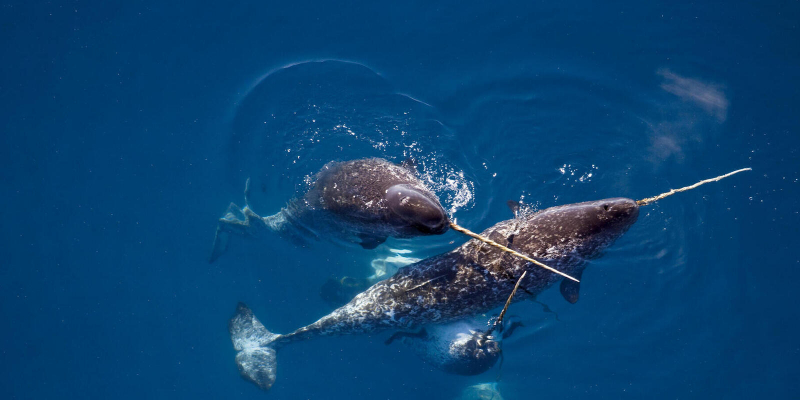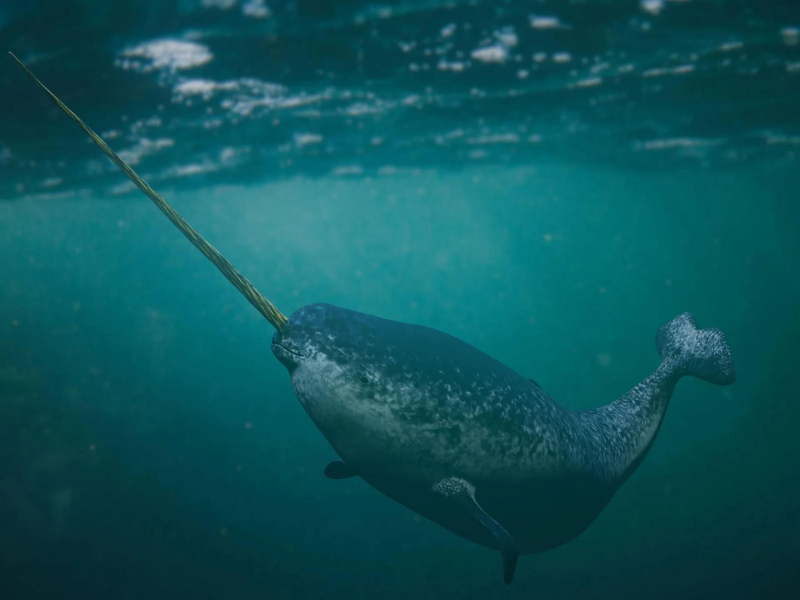Top 9 Interesting Facts about Narwhals
The amazing narwhal affectionately referred to as the "unicorn of the sea," is just as rare as it is unusual. The narwhal has earned its proper place among the ... read more...fabled marine monsters of history thanks to its most distinctive feature, a long tusk that spirals counterclockwise from its top lip. Learn more about the narwhal, one of the planet's most enigmatic marine mammals, including the purpose of its jutting tusks and how they manage to survive for months under sea ice. And there are the most interesting facts about narwhals you can check below!
-
The narwhal's tusk, which may appear to be in the middle of its head, is an enlarged front left tooth that protrudes from the upper lip. The tiny right front tooth typically stays in the mouth. Even stranger, narwhal teeth are the opposite of most teeth (including human teeth) which have a hard outside and a soft, sensitive inner.
"No real shock there. After learning this, Martin Nweeia, a clinical instructor at the Harvard School of Dental Medicine, told NPR that it had been the opposite in every other manner. "But it was quite strange to discover a tooth that is soft on the outside and densest near the pulp."
Narwhal tusks' sensory capabilities were very recently identified. Researchers from Harvard Medical School discovered in 2014 that a narwhal's heart rate changes depending on whether its tusk is exposed to high or low levels of salt in ocean water.
The tusks of narwhals can grow to astonishing lengths of up to 2.6 meters (8.53 ft) throughout the course of their whole lives. A closer inspection reveals that it spirals to the left as it expands.

Photo: https://vajiramias.com/ 
Photo: https://marinemadness.blog/ -
The narwhal's enormous tusk has been the subject of many historical accounts. One hypothesis holds that it can be wielded as a weapon to establish dominance, similar to peacock feathers or deer antlers, although there is insufficient evidence to support this assertion. Another person proposes that it is a strategy for courtship and mate attraction. Researchers gathered biological information on 245 adult male narwhals in 2020 over a 35-year period, tracking growth and variations in tusk length. The larger males in the study had longer tusks, which suggests that larger males are more likely to reproduce.
The most recent theory, however, contends that it functions as a kind of environmental sensor. The study claims that the tusk is permeable and packed with nerves that receive information from the environment, such as water pressure, temperature, and salinity, and relay it to the brain. The researchers fitted narwhals with a kind of "jacket" that protected the tusk from the elements to test this notion. Then, to simulate several types of sea ice, researchers pumped the jacket with water samples with differing salinities. They discovered that the narwhals' heart rates varied in response to changing salt levels, showing that they could perceive the change and respond physically to it. The findings, however, "indicate that narwhals can funnel water into their tusks to detect its salt concentration, regardless of the reason," the researchers wrote.

Photo: https://time.com/ 
Photo: https://www.worldwildlife.org/ -
The majority of tusked animals have tusks on both males and females. However, only about 15% of females and all male narwhals have tusks, which is one of the most interesting facts about narwhals. Researchers find this to be perplexing. Why wouldn't females inherit such an evolutionary feature if the narwhal tusk is, as current studies contend, a method for perceiving the environment? This may provide additional support for the idea that the tusk is primarily a male adornment used to attract attention and establish dominance.
Even more rarely, two tusks have been seen extending on a few narwhals, some of which are on display in the Smithsonian National Museum of Natural History's Sant Ocean Hall.

Photo: https://edition.cnn.com/ 
Photo: https://endangerednarwhals.org/ -
Narwhals are frequently observed making some of the deepest dives among marine mammals throughout the winter. They dive several times every day, preferring the deeper waters of the continental slope and Arctic fjords, where they may go to depths of up to 5,000 feet. Additionally known to frequent deep waters, Greenland narwhals have been observed by biologists to make daily dives deeper than 3,000 feet. A narwhal can submerge for up to three hours every day at a depth of fewer than 800 meters.
The fact that narwhals are so challenging to examine accounts for a large portion of their enigma. The shy animals inhabit environments that are gloomy and covered in ice for most of the year in some of the most remote locations on Earth. Between January and April, the Baffin Bay narwhals had less than 3% access to open water, with a minimum of 0.5 percent open water by the end of March. They are able to stay alive by finding tiny crevices in the ice where they can occasionally breathe while hiding.

Photo: https://www.mensjournal.com/ 
Photo: https://www.newyorker.com/ -
The majority of the prey that narwhals consume is found where open water meets sea ice that is linked to the land. One of the most interesting facts about narwhals is their preferred seafood includes Gonatus squid, shrimp, arctic and Arctic cod, and Greenland halibut.
Researchers know little about the feeding habits of these animals because they catch the majority of their food in the icy, dark waters of the Arctic by diving. The first investigation of narwhal winter feeding patterns wasn't even conducted until 2006 when researchers found that narwhals have access to very limited food throughout the year. The only prey item found in the stomachs of 121 narwhals in the fall was a Gonatus squid.

Sources: https://a-z-animals.com/ Source: https://www.youtube.com/ -
When narwhals are young, their color changes to a bluish-black hue from their birth color of white or light gray. Their skin tone darkens and grows more mottled with age before lightening once more as they get older (older narwhals are almost completely white). Researchers can identify and study baby narwhals in the wild using the color variations, thanks to this color change.
Despite living in one of the most hazardous environments on Earth, narwhals are thought to be among the longest-lived marine mammals, with an average lifespan of 50 years. To demonstrate this, scientists examined chemical changes in the eyes of 75 dead narwhals discovered in Greenland between 1993 and 2004. They found that 20% of the whales were over 50 years old, with the oldest whale being a female who was thought to be between 105 and 125 years old.

Photo: https://www.studiotuesday.com/ 
Photo: https://savethenarwhals.org/ -
Narwhal tusks were once hunted and sold to the wealthy as "unicorn horns" because it was thought that they might counteract poison. Even Mary Queen of Scotts had a personal tusk worth £10,000 in the 16th century to shield her from Queen Elizabeth I.
Additionally, unicorn horns were frequently used in jewelry since it was believed that they might prevent disease. The Imperial Crown Jewels of Austria were made out of a scepter fashioned from a narwhal's tusk surrounded by rubies, sapphires, and pearls, while the Danish Royal Throne used for coronations between 1671 and 1840 was created out of ivory and narwhal tusks.
The narwhal still piques people's attention today, and one of the most intriguing aspects of these animals is their tusk.

Photo: https://www.nationalgeographic.com/ 
Unicorn - Photo: https://www.history.com/ -
Narwhal populations worldwide number about 123,000 mature individuals, with more than three-quarters of them spending their summers in the Canadian Arctic, according to the IUCN Red List of Endangered Species. The narwhal is found in northeastern Canada, Greenland, and northern Russia all the way to the East Siberian Sea, where it is currently classified as being of "Least Concern". Narwhals are thought to exist in 12 subpopulations, with 10 having more than 10,000 individuals and two having fewer than 35,000. The Committee on the Status of Endangered Wildlife in Canada has classified narwhal as a "special concern" in Canada (COSEWIC). This designates species that could become endangered or vulnerable due to a confluence of biological traits and known threats.
Narwhals, like the majority of arctic predators, are highly dependent on sea ice to survive. In order to avoid being eaten by predators like killer whales, they use it to hide. In the Middle East and Southeast Greenland, declining narwhal numbers have been linked to rising water temperatures. Narwhal abundance was lowest whereas summer sea temperatures were highest (43 F) (less than 2,000 individuals).

Photo: https://news.mongabay.com/ 
Photo: https://www.bloomberg.com/ -
The narwhal is one of just two species that belong to the cetacean family monodontidae, the other being beluga whales. These remarkable whales live their entire lives in the icy waters of the Arctic Ocean in Canada, Greenland, Norway, and Russia. They do not migrate.
Narwhals have never been successfully kept in captivity, unlike their beluga cousins. Captive narwhals do not flourish. There were several unsuccessful attempts to catch and maintain some of these elusive whales in aquariums and zoos over a brief period in the 1960s and 1970s, and each one culminated in the animal's tragic demise.
Only one narwhal was on display at a public aquarium in 1970, at the Coney Island location of the New York Aquarium. The narwhal, known as Umiak, only spent a short time in captivity before passing away from pneumonia.

Photo: https://www.americanoceans.org/ 
Photo: https://www.obri-oceanu.com/






























